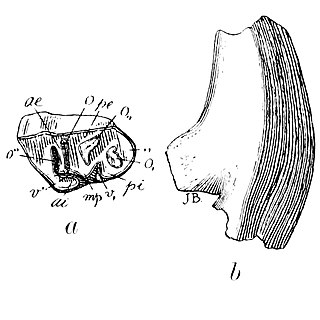
Nepticulidae is a family of very small moths with a worldwide distribution. They are characterised by eyecaps over the eyes. These pigmy moths or midget moths, as they are commonly known, include the smallest of all living moths, with a wingspan that can be as little as 3 mm in the case of the European pigmy sorrel moth, but more usually 3.5–10 mm. The wings of adult moths are narrow and lanceolate, sometimes with metallic markings, and with the venation very simplified compared to most other moths.

Incurvariidae is a family of small primitive monotrysian moths in the order Lepidoptera. There are twelve genera recognised. Many species are leaf miners and much is known of their host plants, excluding Paraclemensia acerifoliella. The most familiar species in Europe are perhaps Incurvaria masculella and Phylloporia bistrigella. The narrow wings are held tightly along the body at rest and some species have very long antennae.

Choreutidae, or metalmark moths, are a family of insects in the lepidopteran order whose relationships have been long disputed. It was placed previously in the superfamily Yponomeutoidea in family Glyphipterigidae and in superfamily Sesioidea. It is now considered to represent its own superfamily. The relationship of the family to the other lineages in the group "Apoditrysia" need a new assessment, especially with new molecular data.

Neofriseria is a genus of moths in the family Gelechiidae.

Carcina quercana is a species of moth of the family Depressariidae. It is found in Europe. It has been introduced recently in North America, British Columbia and western Washington. It is occasionally known by several common names including oak lantern, long-horned flat-body, and oak-skeletonizer moth.

Bisigna procerella is a moth of the family Oecophoridae. It is found in Europe.
Ortalotrypeta singula is a species of tephritid or fruit flies in the genus Ortalotrypeta of the family Tephritidae.

Pulicaria dysenterica, the common fleabane, or, in North America, meadow false fleabane, is a species of fleabane in the family Asteraceae. It is native to Europe and western Asia where it grows in a variety of habitats ranging from semi-arid Mediterranean woodlands to wetter situations. Pulicaria dysenterica is perennial and can form dense clusters of plants, spreading by its roots. It flowers at its maximum height of about 60 centimetres (2.0 ft). Leaves are alternately arranged and clasp the stem, which itself contains a salty-astringent liquid. The yellow inflorescences are typically composed of a prominent centre of 40–100 disc florets surrounded by 20–30 narrow, pistillate ray florets. When setting seed the flower heads reflex.

Neofriseria peliella is a moth of the family Gelechiidae. It is found in most of Europe east to the Ural Mountains. Outside of Europe, it is found in Turkey and North Africa.
Neofriseria mongolinella is a moth of the family Gelechiidae. It is found in Russia and Mongolia.
Neofriseria sceptrophora is a moth of the family Gelechiidae. It is found in Afghanistan and Turkey.
Neofriseria kuznetzovae is a moth of the family Gelechiidae. It is found in Moldova, Ukraine and Russia.

Epermenia is a genus of moths in the family Epermeniidae. The genus was first described by Jacob Hübner in 1825.
Neofriseria baungaardiella is a moth of the family Gelechiidae. It was described by Peter Huemer and Ole Karsholt in 1999. It is found in Greece, southern Spain and Portugal.
Neofriseria pseudoterrella is a moth of the family Gelechiidae. It was described by Rebel in 1928. It is found in Spain.
Neofriseria caucasicella is a moth of the family Gelechiidae. It is found in the Caucasus and Moldavia. Records from Ukraine are based on misidentifications.
Neofriseria turkmeniella is a moth of the family Gelechiidae. It is found in the Uzbekistan, Turkmenistan, southern Kazakhstan and Tajikistan.

Acacia singula is a shrub belonging to the genus Acacia and the subgenus Juliflorae that is endemic to western Australia

Argyrohippus is an extinct genus of notoungulate, belonging to the family Notohippidae. It lived from the Late Oligocene to the Early Miocene, and its fossilized remains were found in South America.









